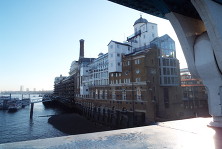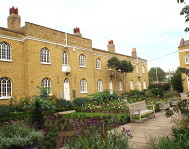








Borough Road
Borough Road 1830
When Westminster Bridge was built in 1750, the second bridge in London to cross the River Thames, Borough Road was constructed to enable traffic from Kent and Surrey to access the bridge. The new road ran from Borough High Street across what were then the open marshy fields and pastures of St George’s Fields, but with the population of London growing quickly, the open land was soon built upon with often small and badly built houses. Major infrastructure occurred in the early 1860s when the London Chatham and Dover railway line was built on a brick viaduct that cut across Borough Road to take trains from the Elephant and Castle to Blackfriars, now a part of Thameslink. Borough Road Station was built on the north side of Borough Road and West of Southwark Bridge Road but was closed in 1907 and most traces of the station have now disappeared.
Dominating the road to the north east was the King’s Bench Prison built in 1758 until it was closed and demolished in the 1870s. It was replaced by Queen’s Buildings, blocks of seven storey model housing tenements that were built on the site in 1881. These were not as well designed as other model housing dwellings and blocked out the sun on every side and rendered the lower floors dark on even the brightest days. The estate suffered some bomb damage in World War II and was demolished as unfit for human habitation in 1977. The gloomy tenements were replaced by the existing more modern social housing built by Southwark Council.
There are many interesting older buildings that remain in Borough Road including the Library which opened in 1899.
Murphy House is one of three housing blocks built at the end of the 19th century by the LCC and managed now by Southwark Council. Borough Road is within the parish of St George the Martyr and there is a relief on the front of Murphy House that depicts St George slaying the dragon.
No. 62 Borough Road is a very pleasing building and was believed at one time to be the watch-house for the King’s Bench Prison. It was in fact built in 1821 by stone mason Henry Robert Hartley on land leased to him by the City of London Corporation. Until at least the 1950s, the house and adjoining yard were in use as a stone mason or builder’s yard. The building is Grade II listed and is now residential.
There are currently (2015) redevelopment proposals pending for the south east corner of Borough Road named the Borough Triangle which takes in the area bordered by Borough Road, Newington Causeway and the railway. At one stage, the former printing factory called Diary House after Charles Letts & Co who owned the premises, now offices for IPSOS MORI, and the Baptist Chapel at No. 82 were under threat of demolition but latest plans show these buildings are to be retained.
Not so lucky is No 83 which is currently home to the London School of Musical Theatre. An unusual building reminiscent of Disney castles, it has been described by Pevsner as a mixture of gothic and Scottish baronial. Designed by C Ashby Lean, it was built in 1906 for the South London Institute of the Blind. A foundation stone, laid by the Duke of Argyll on 24 May 1906, is inset into the building. It records the charity’s Patron was Lord Llangattock, a local
landowner and benefactor who had already donated land in North Camberwell for the building of the library and wash-house. By the 1980s, the building at 83 Borough Road had become a branch of Barclays Bank, and after lying empty for some years became home to the London School of Musical Theatre. Hopefully, such a unique building will escape demolition.
Located at 47-60 Borough Road is a grand neo classical building that was built in 1889 to house the factory for Day and Martin, manufacturers of boot blacking. Though more restrained, it was very similar to their previous factory in High Holborn which had burnt down. The factory in Borough Road was in use by Day and Martin until at least 1925 and a full history of the company can be found here. The building is Grade II listed and is currently used as offices by the International Transport Workers Federation.
Web discoveries
- UK Casino Not On Gamstop
- UK Casino Not On Gamstop
- Non Gamstop Casino
- Casinos Not On Gamstop
- Non Gamstop Casinos
- Non Gamstop Casinos
- Non Gamstop Casino
- Casino Sites Not On Gamstop
- Slots Not On Gamstop
- Casinos Not On Gamstop
- UK Betting Sites Not On Gamstop
- UK Casino Not On Gamstop
- Best Non Gamstop Casinos
- Betting Sites
- Non Gamstop Casino Sites UK
- Best Non Gamstop Casinos
- Non Gamstop Casino
- Casinos Not On Gamstop
- Non Gamstop Casino Sites UK